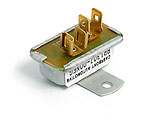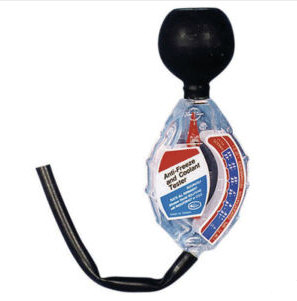Voltage Regulator: High Temps and Fuel
Lorne Goldman at the eMog Pub
The symptoms are: Car appears to warm up normally,
taking about 5-10 minutes of driving in ambient temps of about 9C to warm up to normal temp of 90C. But then the temp gauge
just carries on climbing. After half an hour or so it's nudging 140 C.
But: The fan doesn't automatically cut in, and on
opening the bonnet there's none of the associated smell or sense of an overheating engine. Cheers, Tim
Firstly, you are not overheating. Forget that possibility.
You would know it, you would smell it, your rad fan would be on continually and your rad would be overflowing.
Your water temp gauge is effected by a limited number
of things.
1. Your voltage stabilizer. This items alters and maintains
your 12 Volt to a 10V supply to your fuel gauge  and
water temp gauges. If the screw holding it at the tab looses, the
stabilizer's earth wire, held by the same screw, can lose a proper
contact
and the current to the gauges will jump to your alternator's output (14
+or-.5V). That will make your fuel level and water temp jump
considerably. First, verify that the stabilizer is earthed (grounded)
by testing it on the body of the stabilizer. 90% of problems are
resolved right here.
and
water temp gauges. If the screw holding it at the tab looses, the
stabilizer's earth wire, held by the same screw, can lose a proper
contact
and the current to the gauges will jump to your alternator's output (14
+or-.5V). That will make your fuel level and water temp jump
considerably. First, verify that the stabilizer is earthed (grounded)
by testing it on the body of the stabilizer. 90% of problems are
resolved right here.
2.
Your voltage stabilizer has failed. I had a run of 4 (all sourced
from the US while mogging there. They all failed. [i](This is not an
indictment of the US automobile aftermarket industry..which I dearly
love
but it is best to buy this type of British parts from Britain. It is
also much cheaper.[/i] I then switched to another source, namely
Caerbont who
now manufactures Smiths) (They sell to Holden, Moss, Europe,
Morgan..etc etc) and this resolved the problem.
You
can test this item. You cannot detect the proper output
from a stabilizer, but you can substitute something you know is putting
out 10V. If you passed #1, get another battery and let it run down to
10V.
Earth it on the car and have it feed your fuel of temp gauge directly
(no stabilizer in between). If your temps now behave, the stabilizer is
blown.
BTW, I purchased the other 10V stabilizer (1.5 amp) from
http://www.digikey.com #UA7810CKC They are 40 pence each rather than 8
pounds. Read this article
. Try your neighborhood Radio Shack or computer repair place.
3. The wire from the temp sender on the engine block is
earthed somewhere. To test, you could simply put in another wire from the
sender temporarily and loop it around to the gauge.
4. If you pass..#1-3 the sender is gone. Not unheard of.
It must be replaced.
5. I have not seen this yet, but I imagine the gauge itself
can go.
The key is that if it is the voltage stabilizer is abnormal
in some way, both the fuel level and the water temp will be effected.
TESTING YOUR COOLANT FOR DAMAGING
ELECTROLYSIS
from Tim at Ron Davis Racing
A voltmeter capable of reading both AC and DC currents
is required to test cooling systems. The meter needs to read zero to the
maximum voltage of the system being tested in tenths of a volt. The meter
leads must be long enough to reach between the coolant and the ground side
of the battery. An ohm function of a voltmeter is very helpful to pinpoint
areas of resistance in as electrical system that will cause an electrical
current to ground through the coolant rather than the engineered electrical
circuit.
PROCEDURE
1. Attach the proper meter lead to the ground side
of the battery, negative-to-negative or positive-to-positive.
2. Install the second lead in the coolant touching
the coolant only.
3. Read the DC and AC voltage with all systems
off. If a block heater is present, also take a reading with the heater
turned on. If an automatic battery charger is present, as a standby system,
also take a reading with this system running.
4. Read the DC and AC voltage with the electrical
starter engaged.
5. Read the DC and the AC voltage with the engine
running and all systems turned on: lights, coolers, fans, heaters, air
conditioning, cell phone, two-way radio, including the phone and radio
on both standby and transmit.
6. The above procedure will test a complete system except
for an electrical current, which can be generated by the rear end transmission.
This is particularly true with air bag suspensions, rubber pad suspensions
and rubber-mounted transmissions. Any current generated will travel up
to the drive shaft to ground through the engine coolant. Grounding rear
ends and transmissions is strongly recommended.
7. Voltage of zero to .3 is normal in a coolant
of cast iron engine. Such an engine will be destroyed with time by .5 volts,
and engine manufactures are reporting .15 volts will slowly destroy an aluminum
engine.
8. The current will be AC if the problem is due to static
electricity.
9. If the coolant shows an electrical problem with
all the equipment turned on; turn off one system at a time until you finally
turn off the system that stops the electrical current. When the current
stops, this will indicate the electrical system causing the problem.
10. Be partially careful of starters. They can
cause as much damage to a cooling system as much as a direct connection
to an arc welder! This is due to the amperage present.
11. Always change the coolant if a current is detected.
The electrical current will destroy the protecting chemicals in a properly
inhibited coolant.
Whys & Wherefores by J.F. Frot
Electrolysis needs an anode, a cathode and a conductor between the two.
In an automobile, the coolant plays the role of the latter. Pure water,
distilled water and (even BETTER) demineralized (aka deionized) water are, in theory,
non conductive (although no money would make me hold a power drill in a
bucket of any water and press on the button). Hence no current and no
electrolysis between the different metals. Great benefit there.The
coolant additives are supposed to neutralize the salts collected from
the rock they run through or in the reservoirs and that you get from the
tap or in bottled water. Interestingly, the suppliers pride themselves
on the good salts that their water contains: calcium, magnesium,
potassium, added fluoride, etc. which are indispensable for our
metabolism to function correctly. However they have a disastrous effect
on metal machinery and the bi-metal corroding effect. As soon as you
pass the 65°C mark. The calcium carbonate and the like precipitate and
build up on the walls of the circuit and take the role of insulator to
the heat transfer.
The
efficiency of the additives to neutralize the coolant is questionable.
I used to run very large superheated steam boilers on crude oil
carriers when I was in the merchant navy and it takes far more than a
bit of glycol and a drop of hydrazine to avoid the destruction of a
turbine in record times. So, again, demineralized water is a better
option than relying on the coolant and its additives.
Personal Note: In
my Edwardian and vintage cars, coolant had an adverse effect. For a
reason I do not know, they corrode the nickel that the outside of the
radiator is plated with. So I do not use them and as soon as the roads
are gritted, I empty the circuits and they stay in the garage until late
March. As they work on the thermosyphon principle and under no
pressure, they consume a fair amount of water. So I use the stuff from
the water but, rain water, (you could call it cold distillation or
evaporated water) with very good results for the last forty years. We
also collect rain water at the steam museum where we run a 600 HP
compound engine with very little corrosion of the boiler or the
cylinders.
On modern engines, the coolant is indispensable to
avoid frost damage to the engine block as before but essentially to
raise the boiling point and cope with any summer traffic jam (if the
water pump and the fan are in good order). So, great benefits to be had
there. My tuppence on the subject.
|

TESTING COOLANT USAGE & QUALITY
by Lorne Goldman
After a period of usage, the effectiveness of coolant deteriorates. This can be tested in two ways, both convenient.
1. There is the conventional method with a coolant tester..an
inexpensive device that can be purchased at any auto store or online.
Looks a little bit like a turkey baster and functions the same way. You
simply have it suck up some coolant and read what it tells you.
2. The second, newer method is to buy inexpensive tests strips. Dip the
strip into the coolant and the color it changes to will indicate the
effectiveness of the coolant. The strips are also inexpensive and
easily found.
 and
water temp gauges. If the screw holding it at the tab looses, the
stabilizer's earth wire, held by the same screw, can lose a proper
contact
and the current to the gauges will jump to your alternator's output (14
+or-.5V). That will make your fuel level and water temp jump
considerably. First, verify that the stabilizer is earthed (grounded)
by testing it on the body of the stabilizer. 90% of problems are
resolved right here.
and
water temp gauges. If the screw holding it at the tab looses, the
stabilizer's earth wire, held by the same screw, can lose a proper
contact
and the current to the gauges will jump to your alternator's output (14
+or-.5V). That will make your fuel level and water temp jump
considerably. First, verify that the stabilizer is earthed (grounded)
by testing it on the body of the stabilizer. 90% of problems are
resolved right here.
